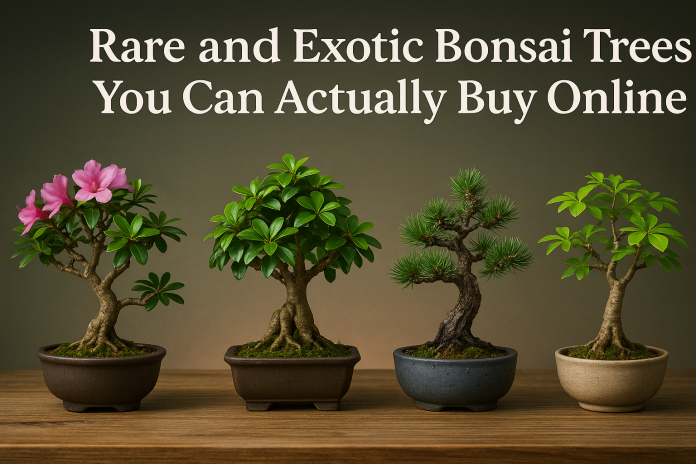Rare and Exotic Bonsai Trees
Welcome to BonsaiTreeForSale.net, your gateway to some of the rare and Exotic Bonsai Trees, captivating and uncommon bonsai specimens available online. From heritage junipers to living forest compositions, we’ll explore rare bonsai that enthusiasts can actually purchase, along with care tips and cultural storytelling.
1. Shimpaku Juniper (Juniperus chinensis ‘Shimpaku’)
The Shimpaku Juniper is a dwarf form of Chinese juniper, originally from Japan, revered for its extraordinary bark, unexpected deadwood (jin and shari), and striking foliage.
Why It’s Rare & Exotic
- Wild-collected shimpakus are endangered in Japan due to over-harvesting .
- Acclaimed bonsai masters like Masahiko Kimura use them for elite masterpieces.
Where to Buy Online
At BonsaiTreeForSale.net, you’ll find nursery-grown Shimpaku available with price tiers depending on trunk thickness and maturity. Browse options here which links to relevant species page.
Care Highlights
- Full sun exposure, USDA zones 3–9
- Well-draining soil, moderate watering
- Annual wiring for the structure and regular pruning to maintain character.
2. Zelkova (Keyaki, Zelkova serrata)
Known in Japanese as Keyaki, the Zelkova serrata is renowned for its vibrant autumn foliage, smooth vase-shaped bark, and elm-like leaf texture.
Unique Qualities
- Highly resistant to Dutch elm disease; prized for street bonsai and urban plantings.
- Aesthetic bark and seasonal color shifts make it ideal for bonsai cultivation.
Where to Find It
BonsaiTreeForSale.net sources Zelkova from bonsai-specialized nurseries—visit the detailed species overview here.
Growing Tips
- Needs full to partial sun; good moisture-retentive soil.
- Growth is moderate; annual trimming promotes dense ramification and autumn display.
3. Yamaki Pine
The Yamaki Pine, a Japanese White Pine with provenance dating back to 1625, is a living legend—it survived the Hiroshima bomb, earning the title “Hiroshima Survivor”.
History & Appeal
- Currently part of the National Bonsai & Penjing Museum collection, a symbol of resilience.
- 300–400 years old, with artistic value in every needle cluster.
Availability & Care
While the museum specimens aren’t for sale, BonsaiTreeForSale.net occasionally lists nursery-grown progeny or saplings derived from its genetic lineage. Search for “Japanese White Pine” listings with Yamaki lineage.
Maintenance Essentials
- Partial sun, slightly acidic bonsai soil.
- Regular candle pruning to refine shoots.
- Wire training is encouraged, but proceed gently due to the delicate bark.
4. Goshin Forest Bonsai
Goshin, meaning “Protector of the Spirit,” is an iconic eleven-tree Chinese juniper forest created by John Y. Naka.
What Makes It Iconic
- A display bonsai at the U.S. National Arboretum.
- Each tree honors one of Naka’s grandchildren, including the original 1948 specimens.
How You Can Own a Goshin-Inspired Bonsai
At BonsaiTreeForSale.net, look for multi-tree Foemina juniper forest kits modeled on Goshin’s layout. Beginner to advanced kits include pot, soil, trainees, and wiring guide (see species info here).
Forest Bonsai Techniques
- Plant multiple saplings in a single tray, wiring for staggered trunks.
- Routine defoliation and clipping enhance forest aesthetics.
- Seasonal root pruning maintains tray balance.
5. Other Rare Species Available Online
• Temple Juniper (Juniperus rigida)
A temple-site native with needle bouquets, ideal for bonsai, light gray-green foliage, and rustic charm.
• Ficus “Indoor” Bonsai
Species like Ficus benjamina, F. salicaria and Portulacaria afra flourish indoors and can be bought as starter bonsai kits .
• Camellia Japonica
Flowering bonsai with small blooms and glossy foliage; seasonal beauty for patios and decks.
6. Choosing the Right Rare Bonsai
Factors to Consider
- Indoor vs outdoor: Pines, junipers, and Zelkova require outdoor exposure.
- Climate compatibility: Shimpaku and Zelkova thrive in Zone 5–8; Ficus and Camellia are tropical.
- Skill level: Shimpaku, forest kits, and Yamaki saplings suit intermediate to advanced growers.
Price vs Value
Expect range:
- Shimpaku: $80–$400 depending on size and wiring.
- Zelkova: $120–$350.
- Forest kits: $50–$200 for beginner trays.
7. Buy Smart: Tips for Online Bonsai Shopping
- Check high-resolution images of trunk, foliage, and root flair.
- Review shipping care: packaged with heat packs, soil stability, and drainage protocols.
- Look for product reviews—site testimonials help track reliability.
- Choose live arrival guarantee—most reputable sellers, including BonsaiTreeForSale.net, include a warranty period.
8. Care & Maintenance for Exotic Bonsai
Watering & Soil
Never let soil dry out entirely, but avoid waterlogged substrates. Use premium, well-draining bonsai mixes.
Pruning & Wiring
- Annual wiring for evergreens, replanted only after 1–2 years.
- Defoliation for deciduous species to reduce leaf size and boost ramification.
Repotting Schedule
- Shimpaku/Zelkova: every 2–3 years (spring).
- Pines: every 3–5 years.
- Forest trays: Every 1–2 years, to adjust spacing and root volume.
Pest & Disease Management
- Spruce: aphids, mites—use neem oil or insecticidal soap.
- Fungus on broadleaf species: use eco-safe fungicides.
- Root health: apply beneficial mycorrhizae during repotting.
9. Further Reading & Resources
- Deep-dive species guides on BonsaiTreeForSale.net—link example: Bonsai Tree Varieties.
- Classic literature: “Bonsai Techniques” by John Naka, “Fine Pruning” by Colin Lewis.
- International bonsai forums and monthly global virtual workshops.
Conclusion
Seeking rare and exotic bonsai trees? You can own living pieces of culture—from the lauded Shimpaku and Yamaki Pine to modern interpretations like forest kits. At BonsaiTreeForSale.net, high-quality specimens and transparent sourcing make owning a piece of bonsai heritage possible. Start your journey today and cultivate more than a tree—a story in miniature
